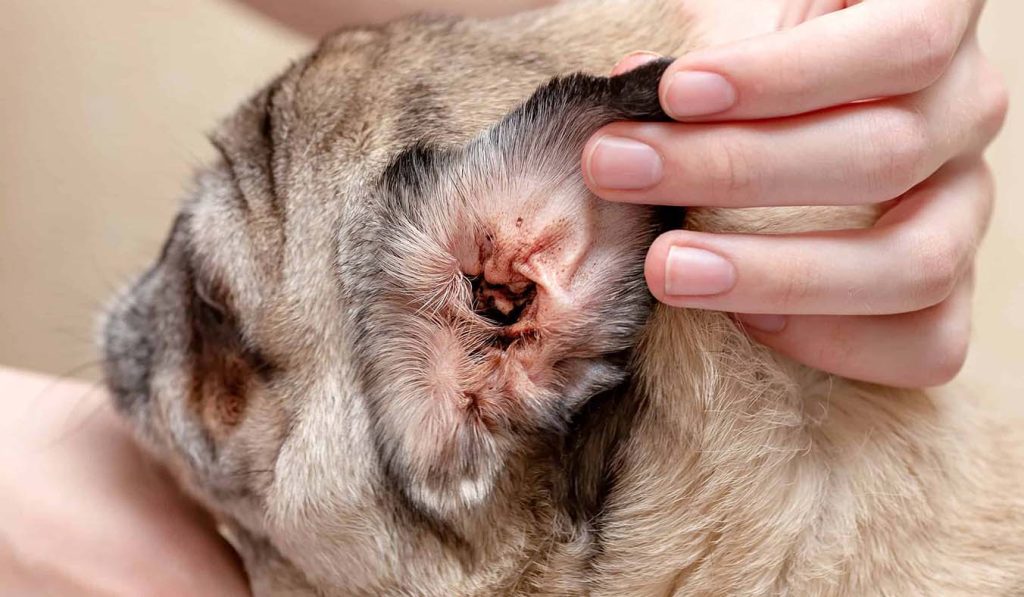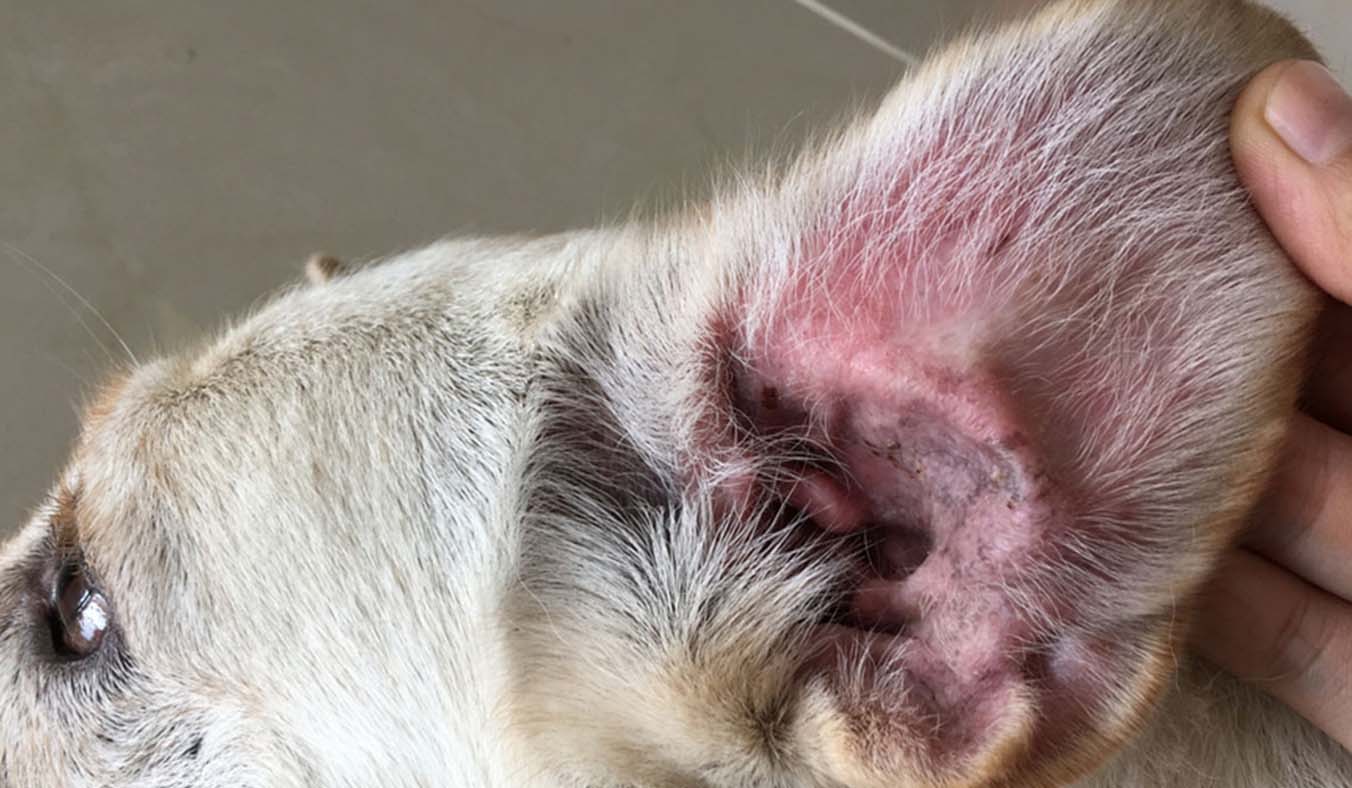Ear infections are a common ailment among dogs and can cause discomfort and distress if left untreated. We’ll explore what canine ear infections entail, how to identify if your dog has one, treatment options, and preventive measures to keep your furry friend’s ears healthy.
What Do Canine Ear Infections Look Like?
Canine ear infections, whether affecting the outer (otitis externa), middle (otitis media), or inner ear (otitis interna), exhibit distinct symptoms indicating their presence. Here’s a detailed overview:
- Ear Discharge: A telltale sign of canine ear infections is the presence of discharge from the ears. This discharge is often characterized by its foul odor and may vary in color from yellow, brown to even bloody, depending on the severity of the infection.
- Odor: Alongside discharge, ear infections typically emit a strong, unpleasant odor. This odor is a result of bacterial or yeast overgrowth within the ear canal and is often indicative of an underlying infection.
- Ear Scratching or Head Shaking: Dogs experiencing ear infections frequently exhibit behaviors such as vigorous scratching at their ears or frequent head shaking. These actions are attempts to relieve itching or discomfort caused by the infection.
- Redness and Swelling: Upon visual inspection, the affected ear(s) may display redness, inflammation, or swelling. These symptoms extend not only to the ear canal but also to the surrounding tissue, contributing to discomfort and pain for the dog.
- Pain or Sensitivity: Dogs with ear infections may demonstrate signs of pain or sensitivity when their ears are touched or manipulated. They may flinch, whimper, or display other indications of discomfort in response to handling.
It’s crucial to be vigilant for these signs and symptoms of ear infections in dogs. If you observe any of these indicators, prompt veterinary attention is essential to diagnose and treat the condition effectively. Early intervention can alleviate discomfort and prevent the infection from worsening, ensuring your dog’s ear health and overall well-being.
How to Determine if Your Dog Has an Ear Infection

If you suspect your dog is suffering from an ear infection, there are several steps you can take to assess their condition before seeking veterinary care:
- Visual Inspection: Carefully examine your dog’s ears for any visible signs of inflammation, redness, swelling, or discharge. Use a gentle touch to avoid causing discomfort to your pet.
- Odor Check: Take note of any unusual odor emanating from your dog’s ears. Foul-smelling discharge is a common indicator of ear infections and warrants further investigation.
- Behavioral Cues: Pay attention to your dog’s behavior. Excessive scratching or rubbing of the ears, head shaking, or tilting of the head to one side may indicate discomfort or irritation in the ears.
- Observation of Symptoms: Monitor your dog for symptoms such as ear sensitivity or pain when the ears are touched or manipulated. Dogs with ear infections may react negatively to ear handling due to discomfort.
- Changes in Hearing: Observe if your dog displays any changes in hearing ability or responds differently to auditory stimuli. Ear infections can affect hearing and may result in behavioral changes related to auditory perception.
While these steps can provide valuable insights into your dog’s ear health, they are not a substitute for professional veterinary evaluation and diagnosis. If you suspect your dog has an ear infection based on your observations, it’s crucial to seek prompt veterinary care. A veterinarian can conduct a thorough examination, perform diagnostic tests if necessary, and recommend appropriate treatment to address the underlying cause of the ear infection and alleviate your dog’s discomfort. Early intervention is key to preventing complications and promoting your dog’s ear health and overall well-being.
Treating Canine Ear Infections
Addressing canine ear infections requires a multifaceted approach to effectively eliminate the underlying infection and alleviate your dog’s discomfort. Here’s what to expect during the treatment process:
- Veterinary Examination: Before initiating treatment, your veterinarian will conduct a thorough examination of your dog’s ears to assess the severity of the infection and identify any underlying causes, such as bacterial or yeast overgrowth, allergies, or ear mites.
- Ear Cleaning: Proper ear cleaning is essential to remove accumulated debris, wax, and discharge from the ear canal, facilitating the penetration of medication. Your veterinarian may perform ear flushing or irrigation using specialized solutions to ensure thorough cleansing.
- Medication Administration: Depending on the type and severity of the infection, your veterinarian may prescribe medicated ear drops, ointments, or sprays containing antibiotics, antifungal agents, or corticosteroids to combat the infection and reduce inflammation. These medications are typically applied directly into the ear canal and may need to be administered multiple times per day for optimal efficacy.
- Oral Medications: In cases of severe or recurrent infections, your veterinarian may prescribe oral antibiotics or antifungal medications to address systemic issues and prevent further spread of infection.
- Follow-Up Care: Throughout the course of treatment, your veterinarian will schedule follow-up appointments to monitor your dog’s progress, assess treatment response, and make any necessary adjustments to the treatment plan. It’s essential to attend these appointments and communicate any changes or concerns regarding your dog’s condition.
- Preventive Measures: To minimize the risk of future ear infections, your veterinarian may recommend preventive strategies such as regular ear cleaning, managing underlying allergies, controlling moisture in the ears, and avoiding exposure to potential irritants or allergens.
- Environmental Management: Creating a clean and hygienic living environment for your dog, free from excessive moisture, dirt, and allergens, can help prevent recurrent ear infections and promote ear health.
- Compliance and Patience: Adherence to your veterinarian’s treatment recommendations and completing the full course of medication is crucial for successful resolution of the infection. Additionally, it’s essential to be patient during the healing process, as it may take time for your dog’s ears to fully recover.
By following these comprehensive treatment protocols and working closely with your veterinarian, you can effectively manage canine ear infections and restore your dog’s ear health and comfort. Remember to seek veterinary guidance at the first sign of an ear infection to prevent complications and ensure the best possible outcome for your furry friend.
Preventing Canine Ear Infections

Maintaining your dog’s ear health is key to preventing the discomfort and complications associated with ear infections. Here are some practical tips to keep your dog’s ears clean and infection-free:
- Regular Ear Inspection: Check your dog’s ears regularly for signs of redness, swelling, or discharge. Early detection allows for prompt intervention before an infection escalates.
- Gentle Ear Cleaning: Use a veterinarian-recommended ear cleanser to gently clean your dog’s ears on a regular basis. Avoid using cotton swabs or inserting anything deep into the ear canal, as this can cause injury or push debris further into the ear.
- Dry Ears Thoroughly: After bathing or swimming, ensure your dog’s ears are thoroughly dried using a clean, dry cloth or cotton ball. Moisture trapped in the ears can create an environment conducive to bacterial or yeast growth.
- Allergy Management: Address underlying allergies, which can predispose dogs to ear infections, through appropriate management strategies recommended by your veterinarian. This may include dietary modifications, allergen avoidance, or allergy medications.
- Regular Veterinary Check-ups: Schedule routine veterinary examinations to monitor your dog’s overall health, including their ears. Your veterinarian can perform thorough ear examinations and provide guidance on preventive care tailored to your dog’s specific needs.
- Avoid Irritants: Minimize your dog’s exposure to potential ear irritants, such as dirt, debris, or harsh chemicals. Keep your dog’s living environment clean and free from allergens that may exacerbate ear issues.
- Prompt Treatment of Underlying Conditions: Address any underlying health conditions that may predispose your dog to ear infections, such as hormonal imbalances, autoimmune disorders, or structural abnormalities.
- Maintain a Healthy Lifestyle: Ensure your dog receives a balanced diet, regular exercise, and proper grooming to support overall health and immune function, which can help prevent ear infections.
By incorporating these preventive measures into your dog’s routine care regimen and staying vigilant for any signs of ear problems, you can help keep their ears healthy and infection-free for years to come. If you notice any concerning symptoms or changes in your dog’s ear health, consult with your veterinarian promptly for evaluation and appropriate management.
By staying vigilant and proactive about your dog’s ear health, you can help prevent ear infections and keep your canine companion happy and comfortable. If you suspect your dog has an ear infection or notice any signs of ear discomfort, don’t hesitate to consult your veterinarian for proper diagnosis and treatment.

.jpg)

